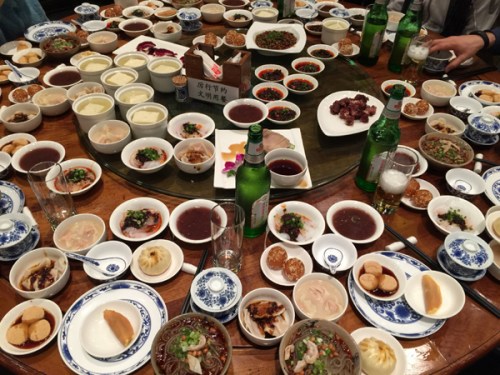
Chengdu, the ancient gateway to the southern Silk Road, has long been a magnet for visitors who love food. Dinner at Shunxing Teahouse. (Photo: Mike Peters/China Daily)
When I was making plans to visit Chengdu, my Western friends wanted to know if I was going to see pandas. (Yes.) My Chinese friends asked if I was planning to eat a local delicacy: rabbit head. (Uh ... maybe? But on Easter weekend?)
The most authentic rabbit head restaurant, according to various reports, is Old Mother From Shuangliu's Rabbit Head, located near Shuangliu Old Station. Locals say "old mother" was selling hotpot at her shop-originally located where the airport sits today-but in the back she often prepared rabbit head for her son, who apparently craved this dish with the homemade sauce he grew up eating. Her hotpot customers "went crazy for it when they got a taste", and the rest is history, or at least her story.
How popular is eating rabbit head here? Local farm production can't keep up with demand-rabbits are now being imported from France for breeding, the Wall Street Journal recently reported.
I did in fact try rabbit's head while strolling along Jinli Street, also known as Chengdu's snack street. You might guess that eating these is a tricky business, requiring the patience and perseverance one needs to eat crabs or lobster.
Cooking these egg-sized goodies is involved, too. First, rabbit heads should be blanched in hot water, then soaked in a mixture of salt, rice wine and ginger for 12 hours. Next comes stewing and then steeping with different flavorings depending on the cook: cinnamon, fennel and chilies are favorites. Finally, they are seasoned with sesame and chili powder and served.
Most delectable, Chinese standing around one vendor tell me, are the cheeks, the tongue and the brain. To get down to business, crack open the jaw and tear the whole head into two halves. The cheeks were the easiest (to contemplate and to eat), and like the tongue these tidbits of meat are quite tasty. I fear I funked my tentative approach to the brain, but a young German girl traveling in our group pronounced the entire eating experience "excellent" and, you guessed it, "tastes like chicken".
Overall, a badge of courage is not really required to appreciate Sichuan food, which is much broader in scope than bunny brains or even the Sichuan peppercorn that now creeps into all kinds of Chinese cuisine. The hot pepper was actually unknown in the area until about 200 years ago, when the historically rather mild cuisine got a kick in the pants after chilies were introduced from South America and became an immediate hit.
The region has high humidity-it can rain 300 days out of the year-and traditional Chinese medicine holds that peppers reduce internal dampness. Now spicy dishes-pungent, hot and salty-have become the norm, though more traditional dishes like crisp duck roasted with camphor and tea, boiled pork with mashed garlic, dry-fried carp, minced chicken with hollyhock, and boiled Chinese cabbage are popular, too.
















































